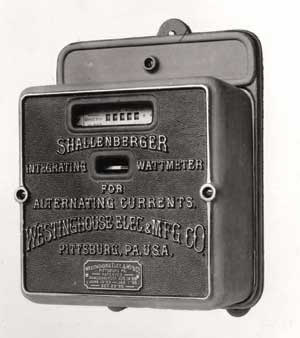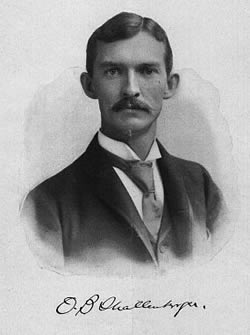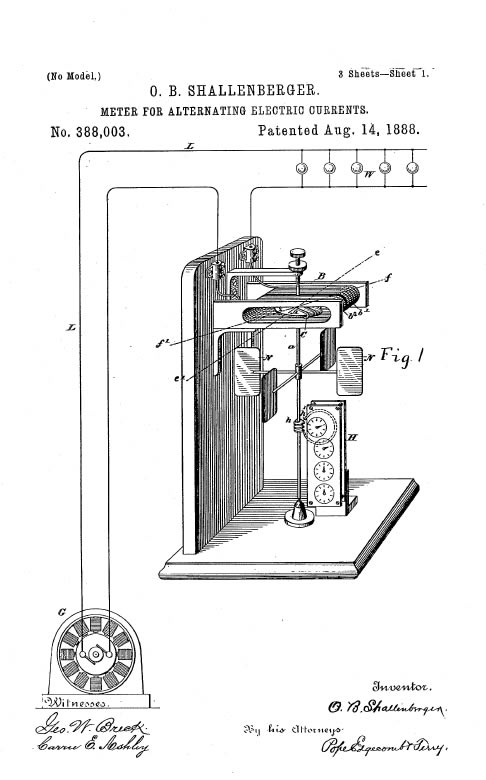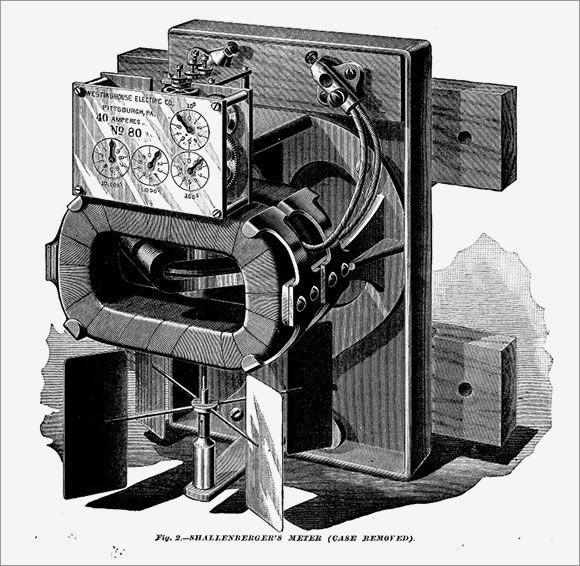
Most of us have paid the electric bill at one point or another (some less frequently and/or punctually than others), but it’s likely few of us have ever stopped and wondered who it was that designed the electric meter mounted to the side of our house. We just go about our daily lives without ever considering such a thing, despite the annoyance of getting a monthly electric bill in the mail. The truth is, however, that without such a design and device, power companies would have no way to regulate and monitor the amount of electricity consumed by each household.
As such, before the invention of the electric meter, power companies had no way to monitor or price the power they supplied to individual households and businesses. And before there were power companies, individual households were responsible for producing their own power. Imagine today if every house was connected to a water wheel, giant windmill, or noisy generator rather than most having a convenient little box counting off every kilowatt-hour consumed. Most people, unless they live by a stream that can turn a water wheel, would opt for the little box and monthly bill.
So, who do we owe credit to for the modern day design of the electric meter that so unassumingly adds up our periodic power usage? His name is Oliver B. Shallenberger, and his invention enabled so many of us to be connected to the grid and charged accordingly. But to understand Mr. Shallenberger’s great contribution and how we have come to be so dependent on electricity, it is helpful to first understand the evolution of this power source.

Most people are familiar with the story of Benjamin Franklin tying a key to a kite and ‘discovering’ electricity when it was struck by lightning. This colorful interpretation of certain events has been skewed from real facts by Americans through its telling and retelling, generation to generation. The truth is people have known about electricity, or at least had some understanding of it, since the Ancient Egyptians. It remained no more than an intellectual curiosity, however, until the late nineteenth century.
It was around this time that a great debate was going on between two famous physicists. Known as the “War of the Currents,” this battle was between Thomas Edison and George Westinghouse over the idea of DC versus AC power for commercial American use. (AC or alternating current is current that flows with a constantly changing magnitude, or goes from positive to negative repeatedly. DC or direct current describes current that is at a constant value with no phase. SPOILER ALERT: Modern American homes and businesses have outlets that supply 120V 60Hz AC power.)
The main reason for this debate was that Edison was the first to design numerous DC-oriented technological advancements, and DC power was the standard in the U.S. In the late 1880s, however, Nikola Tesla came up with the ideas for transformers and other electronic circuits, and AC became much more practical for residential consumption. George Westinghouse bought the rights to Tesla’s polyphase system patents along with other transformer designs and formed Westinghouse Electric & Manufacturing Co. in 1886. Once Westinghouse had the rights and support from Tesla himself, he was able to commercialize the production of AC power in the U.S.
It was around this time that Westinghouse hired an ex-naval officer eager to pursue his interest in electricity. This man was O.B. Shallenberger. And by 1888, Shallenberger had become Westinghouse’s chief electrician.
Though it’s less popular than Ben Franklin’s key and kite legend, the invention of Shallenberger’s meter is a story equally apocryphal. The story goes that while Shallenberger and an assistant were working on an AC arc lamp, a spring fell and came to rest on the inside ledge of the lamp. As the assistant went to reach for it, Shallenberger stopped him when he realized the spring had rotated. Shallenberger eventually discovered that the changing electric fields induced a magnetic field which caused the metal spring to rotate. With this at the heart of his idea, Shallenberger designed an AC ampere-hour meter three weeks later. His design implemented the use of an induction-based motor which comes from coiling a number of current carrying wires together that inherently possess a magnetic field through the beautiful relationship know as electromagnetism.
Using the original figure from the patent Shallenberger received for his design, (B) is the coil of wires that carry the current the resident is using. This current produces a magnetic field which points in the direction through the wires (e and e’). This force acts upon the metal disc or armature (A), causing it to rotate. This rotation spins the metal rod (a) the disc is connected to causing a registering ‘worm’ (h), which is like a screw, to rotate as well. The rotation of this worm turns a ‘worm-gear’ or wheel, which is connected to a registering train that is calibrated to display the amount of electricity used. The registering train is like a bunch of dials that point to numbers that represent the amount of current used. Also connected to the rod are four fan blades (N), which are used to slow down and eventually stop the disc from spinning once the force is removed (i.e. once the current stops flowing). The systems were calibrated by using a known amount of power and then using a little algebra and testing to determine coefficients, which took the fans retarding force into effect along with friction in the bearings between the disc and mounting rod, and in the gears.
Overall the design was simple yet ingenious and very effective in doing what it needed to do, so much in fact that the same design is still used in most meters today albeit with some modern day improvements. Shallenberger himself was responsible for many improvements and reinventions of his first AC electric meter and received a number of patents because of it. The reason the design was and still is so effective is because it consumes very little power assuring that customers only pay for the power they are using, while still being very accurate in recording power consumption. Modern day electric meters now use better materials for the armature and rod, along with better casings and registering components to minimize external defects.
According to the 1903 textbook Electrical Engineering: Measuring Instruments for Commercial and Laboratory Use, “It has already been pointed out that the great trouble in the generality of motor meters is the friction of the moving parts, which, if not minimized and compensated for, causes irregularities in the direct proportion between speed and the thing measured.” Shallenberger’s design uses the induced magnetic field from the current to measure the amount of current used which consumes little to no power. The textbook goes on to say, “Consequently it is an advantage that there should be no rubbing contacts in the meter, other than, of course, in the bearing, which can be minimized, but not entirely eliminated.” Shallenberger also did this by using gears, turned by the disc and rod, which had very little friction. “ A meter made…that fulfills the above requirements in a highly satisfactory degree is that introduced by Mr. Shallenberger some years ago, and which may be said to be one of the most satisfactory coulomb-motor meters in existence at the present day.” (Meters intended to measure electric quantity are called coulomb meters) These statements of praise still hold true just as they did over a hundred years ago.
Once electric companies had an effective way to monitor the power consumption of individual households and businesses, the Second Industrial Revolution ensued as rural areas received electricity. Since then, electricity has become an absolute necessity for modern day living. Every appliance and luxury electronic in a typical household runs on electricity provided by the local power company, and will continue to do so for quite some time.
Through the development of other technologies like computers and highly sophisticated communication systems, electric meters have begun to evolve into more technologically advanced systems as well. Concepts such as Smart Grids and AMRs (automatic meter readings) have become integrated with the electromechanical electricity meters that are based on Shallenberger’s original design. These newer technologies eliminate the need for the ‘meter man’ to get the reading from the meter itself. Essentially the registering system in the original design has gone from analog to digital and can now send readings to huge databases for billing, analysis, and troubleshooting. Smart Grids even take it a step further and can actually give real-time readings from anywhere as well as statistically determine how much power individual households will use allowing for more efficient power consumption.
They say the greatest ideas are those that stand the test of time. O.B Shallenberger’s design of an induction motor-based electricity meter is still used in most meters today. The simple yet effective design has been able to monitor and register power consumption of individual households and businesses for over a century. Despite our shared dislike of paying the electric bill, if no one has complained enough to make it change, we must be getting a fair deal after all.
Sources:
- Brown, C.N. “Charging for electricity in the early years of electricity supply.” IEEE Proceedings. 132.8 (1985): 513-24.
- Dahle, David. “Dave.” Westinghouse Electric (& Mfg.) Co. (1886-1990). 2 Nov. 2009. (16 Feb. 2010). <http://watthourmeters.com/westinghouse/>.
- Dahle, David. A brief history of meter companies and meter evolution. 2 Nov. 2009. (16 Feb. 2010). <http://watthourmeters.com/history.html>.
- Parr, G. D. Aspinall. Electrical Engineering Measuring Instruments for Commercial and Laboratory Purposes. Blackie & Son: London, 1903. p. 284-8.
- Shallenberger, Oliver B. “Armature for Electric Meters.” Patent 426,335. 22 Apr. 1890.
- Shallenberger, Oliver B. “Meter for Alternating Electric Currents.” Patent 388,003. 14 Aug. 1888.
- Shallenberger, Oliver B. “Method of Measuring Alternating Electric Currents.” Patent 388,004. 14 Aug. 1888.
- Shallenberger’s Electric Meter. 7. New York, NY: Electrical Engineer, 1888. p. 382-4.


